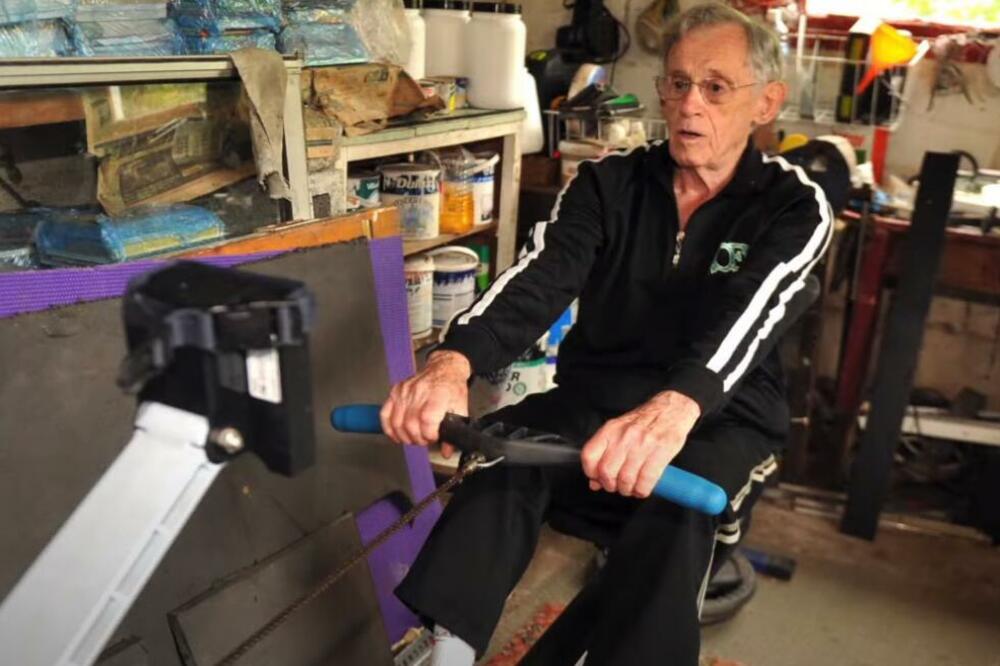The Irishman Richard Morgan, who is 93 years old, is a four-time world champion in indoor rowing.
He has the body fat percentage of a whippet (a British breed of medium-sized, greyhound-type dog). He is also the subject of a new study published last month in the Journal of Applied Physiology that looked at his training, diet and physiology, the Washington Post writes.
The results suggest, in many respects, that he is an example of healthy aging, a nonagenarian (a person who is between 90 and 99 years old), with the heart, muscles and lungs of someone twice his age.
But in other respects, he's ordinary, a one-time baker and battery maker with creaky knees who didn't exercise regularly until he was well into his 70s, still training mostly in his backyard shed.
Although his fitness routine started later in life, he has now rowed the equivalent length of nearly going around the world 10 times, and won four world championships.
Lessons on aging from active seniors
"We need to look at very active older people if we want to understand aging," said Bas Van Hooren, a researcher at Maastricht University in the Netherlands and one of the authors of the study.
Many questions remain unanswered about the biology of aging, and whether the physical slowing and decline in muscle mass that typically occurs as we age are normal and inevitable or perhaps due, at least in part, to a lack of exercise.
What made Morgan particularly interesting to researchers was that he didn't start playing sports or exercising until he was 73. Retired and a bit lost at the time, he attended rowing with one of his grandsons who was a competitive rower in college. The trainer invited him to use one of the machines.
Highest recorded heart rate
In order to find out more, they invited Morgan, who was then 92 years old, to the physiology laboratory at Ireland's University of Limerick, measuring his height, weight and body composition and collecting data on his diet. They checked his metabolism, heart and lung function.
They asked him to sit on a rowing machine and do a simulated 2.000 meters while his heart, lungs and muscles were monitored.
"It was one of the most inspiring days I've ever spent in the lab," said University of Limerick Professor of Healthy Aging Physical Performance and Nutrition Philip Jakeman.
Morgan turned out to be a nonagenarian, his wiry 75 pounds composed of about 80 percent muscle and barely 15 percent fat, a body composition that would be considered healthy for a man decades younger.
While rowing his heart rate peaked at 153 beats per minute which is above the expected heart rate for his age, a result that is right at the top for someone in his 90s
"His heart rate went up quickly, which means his heart was able to quickly supply his working muscles with oxygen and fuel," said exercise assistant Lorcan Daly.
Exercise 40 minutes per day
Perhaps most impressively, he developed this fitness with a simple, relatively abbreviated exercise routine, the researchers noted:
Consistency: Every week he rows about 30 kilometers (about 18,5 miles), averaging about 40 minutes a day.
A mix of easy, moderate and intense training: About 70 percent of these workouts are easy, where Morgan barely works. The other 20 percent is at a difficult but tolerable pace, and the last 10 percent is full steam with a barely sustainable intensity.
Weight training: Two or three times a week, he also weight trains, using adjustable dumbbells to complete about three sets of lunges and curls (exercises in which the weight is pulled toward the body) repeating each movement until his muscles are too tired to would continue.
High protein diet: He eats a lot of protein, his daily intake exceeds the usual recommendation of around 60 grams of protein for someone his weight.
How exercise changes the way we age
"This is an interesting case study that sheds light on our understanding of exercise adaptation across the lifespan," said Scott Trappe, director of the Human Performance Laboratory at Indiana University.
"We're still learning about starting an exercise program late in life," he added, "but the evidence is pretty clear, the human body maintains the ability to adapt to exercise at any age."
Morgan's fitness and physical strength at age 93 suggest that "we don't have to lose" large amounts of muscle and aerobic capacity as we age, Jakeman said.
"Exercise can help us build and maintain a strong, fit body, at any age," he added.
Of course, Morgan has some genetic advantages, the scientists pointed out. Rowing skills seem to run in his family.
His performances were slower than in previous years. Exercise will not erase the effects of aging, but it can slow body loss.
It also offers rewards, "There's a certain satisfaction in winning world championships," Morgan told me through his grandson.
"I started from scratch," he said, "and suddenly I realized that there is a lot of satisfaction in this."
Bonus video:




